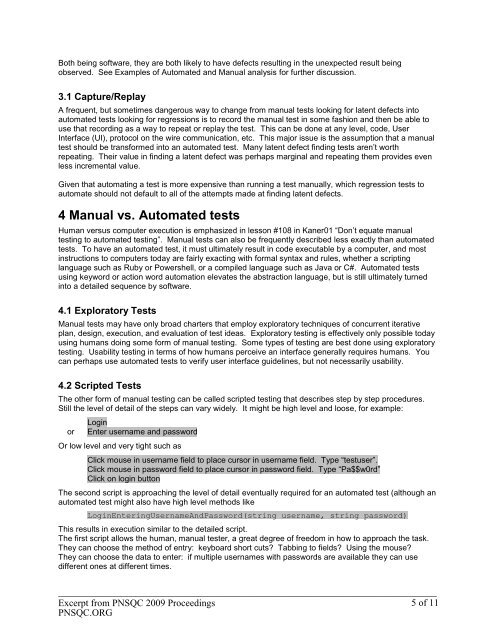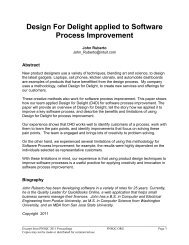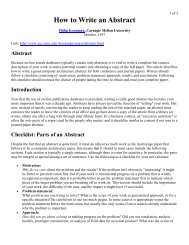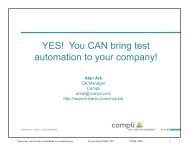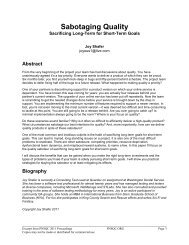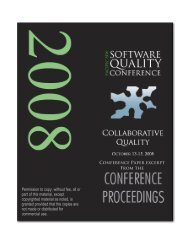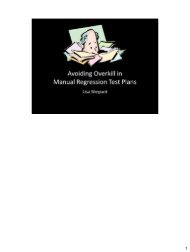Too much automation or not enough? - PNSQC
Too much automation or not enough? - PNSQC
Too much automation or not enough? - PNSQC
- No tags were found...
You also want an ePaper? Increase the reach of your titles
YUMPU automatically turns print PDFs into web optimized ePapers that Google loves.
Both being software, they are both likely to have defects resulting in the unexpected result beingobserved. See Examples of Automated and Manual analysis f<strong>or</strong> further discussion.3.1 Capture/ReplayA frequent, but sometimes dangerous way to change from manual tests looking f<strong>or</strong> latent defects intoautomated tests looking f<strong>or</strong> regressions is to rec<strong>or</strong>d the manual test in some fashion and then be able touse that rec<strong>or</strong>ding as a way to repeat <strong>or</strong> replay the test. This can be done at any level, code, UserInterface (UI), protocol on the wire communication, etc. This maj<strong>or</strong> issue is the assumption that a manualtest should be transf<strong>or</strong>med into an automated test. Many latent defect repeating. Their value in finding a latent defect was perhaps marginal and repeating them provides evenless incremental value.Given that automating a test is m<strong>or</strong>e expensive than running a test manually, which regression tests toautomate should <strong>not</strong> default to all of the attempts made at finding latent defects.4 Manual vs. Automated testsHuman versus computer execution is emphasized in Manual tests can also be frequently described less exactly than automatedtests. To have an automated test, it must ultimately result in code executable by a computer, and mostinstructions to computers today are fairly exacting with f<strong>or</strong>mal syntax and rules, whether a scriptinglanguage such as Ruby <strong>or</strong> Powershell, <strong>or</strong> a compiled language such as Java <strong>or</strong> C#. Automated testsusing keyw<strong>or</strong>d <strong>or</strong> action w<strong>or</strong>d <strong>automation</strong> elevates the abstraction language, but is still ultimately turnedinto a detailed sequence by software.4.1 Expl<strong>or</strong>at<strong>or</strong>y TestsManual tests may have only broad charters that employ expl<strong>or</strong>at<strong>or</strong>y techniques of concurrent iterativeplan, design, execution, and evaluation of test ideas. Expl<strong>or</strong>at<strong>or</strong>y testing is effectively only possible todayusing humans doing some f<strong>or</strong>m of manual testing. Some types of testing are best done using expl<strong>or</strong>at<strong>or</strong>ytesting. Usability testing in terms of how humans perceive an interface generally requires humans. Youcan perhaps use automated tests to verify user interface guidelines, but <strong>not</strong> necessarily usability.4.2 Scripted TestsThe other f<strong>or</strong>m of manual testing can be called scripted testing that describes step by step procedures.Still the level of detail of the steps can vary widely. It might be high level and loose, f<strong>or</strong> example:<strong>or</strong>LoginEnter username and passw<strong>or</strong>dOr low level and very tight such asClick mouse in username field to pClick mouse in passw<strong>or</strong>d field to pClick on login buttonThe second script is approaching the level of detail eventually required f<strong>or</strong> an automated test (although anautomated test might also have high level methods likeLoginEnteringUsernameAndPassw<strong>or</strong>d(string username, string passw<strong>or</strong>d)This results in execution similar to the detailed script.The first script allows the human, manual tester, a great degree of freedom in how to approach the task.They can choose the method of entry: keyboard sh<strong>or</strong>t cuts? Tabbing to fields? Using the mouse?They can choose the data to enter: if multiple usernames with passw<strong>or</strong>ds are available they can usedifferent ones at different times.______________________________________________________________________________Excerpt from <strong>PNSQC</strong> 2009 Proceedings5 of 11<strong>PNSQC</strong>.ORG


